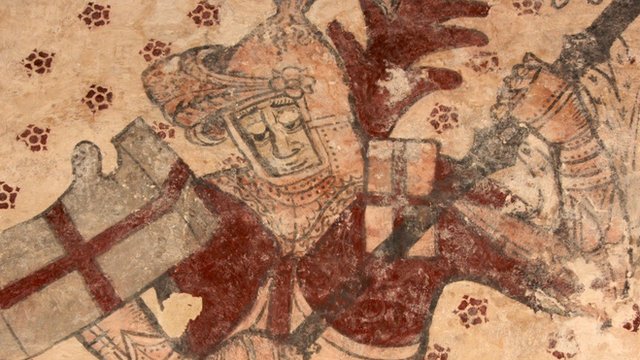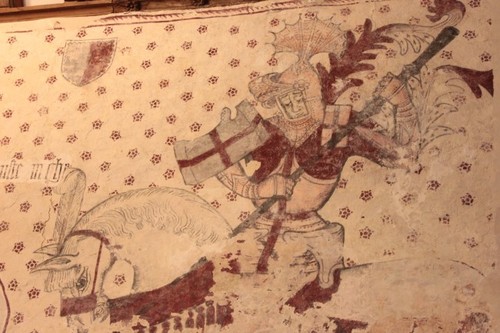
Although they seem to have forgotten the word, this is obviously iconography in a Welsh Church, in the Medieval European style – Orthodoxy in the life blood of Welsh churches.
Built on the site of a 7th century monastery and founded around 1200, St Cadoc’s in Llancarfan, Vale of Glamorgan is, from the outside, just another beautiful small Welsh village church.
But inside, conservators have uncovered some stunning 15th century wall paintings to the delight of locals, visitors and experts alike.
After the discovery of a thin red line of paint on the wall, a team of experts were brought in to investigate what else was lurking behind the 20 layers of limewash added over five centuries.
Now, after five years of restoration work, the church is revealing its treasures: startlingly bold images of the seven deadly sins, a royal family, a ghoulish death figure – and what has been described as one of the largest and most spectacular tableaux of St George and the Dragon ever seen in a British church.
The work was funded by local trusts, Wales’s heritage body Cadw and the Heritage Lottery Fund.
Having been closed except for services during the long periods of conservation work, St Cadoc’s is now ready for the public to see the pictures for themselves.


Greath! St. Gyorgy pray for us and Wales and the World!
Careful Art scholarship is necessary on this rendition before making rash statements about its alleged “Icon” status, and thereafter treating it as an Icon. It is in a continental Norman style and not of a style that is indigenous to the Celtic Nations.
Besides, the Welsh themselves would not have commissioned it due to the murder of non-Roman Welsh monks on the Isle of Anglesey by the henchmen of Augustine of Aosta (Canterbury) in the 600-604 period.
In any case, the Patron Saint of Wales is St Dewi (David), and not St George (of England).
It is more likely of English Origin, given its dating as listed above. During this period, the Norman English decorated the walls of Church buildings with secular themes, whilst at the same time encouraging stained glass windows in the Templar-Gothic style (the true Western Latin Icon) after Chartres Cathedral in France.
I would be wary of claiming this as true Iconography, notwithstanding similar renditions of essentially the same subject in the Orthodox East and represented in the East as an erstwhile Icon..
It is very similar in religious orientation to that of the Bayeux Tapestry – which I cannot recall any Orthodox Church acclaiming as an “Icon”, and conversely, it is a spiritual world away from the Illuminations in the Book of Kells.
While I could go on, I trust that this brief thumbnail sketch injects a note of warranted caution into this whole matter. I for one, would not claim it as an Icon, as much as I would like to.
Regardless of one’s opinion of what ‘true iconography’ is – this is a painted image of an Orthodox saint on a church wall. It’s an icon.